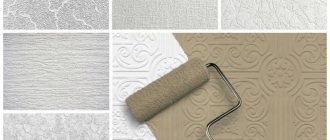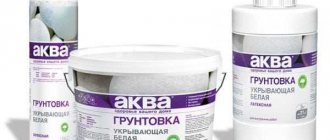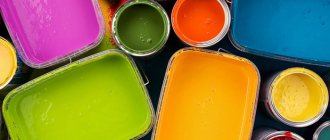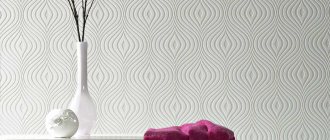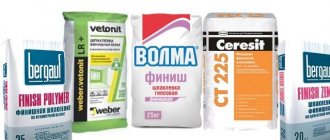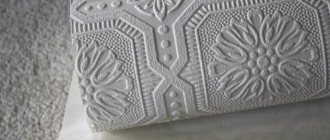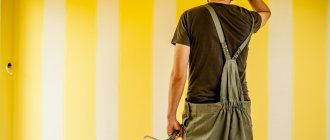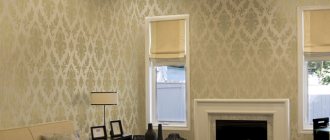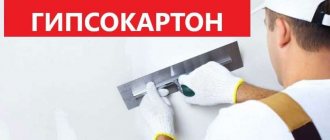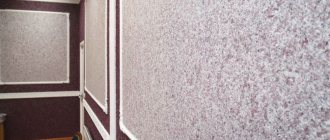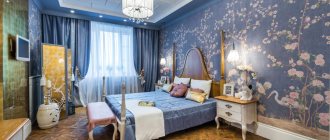Paintable wallpaper: features
It is believed that wallpaper is the most popular material for wall decoration. This is due to their low cost, ease of use, and ease of maintenance. Well, those that could be repainted in different colors are a real find. In most cases, this material is completely white, and only in 3-5% of cases do manufacturers produce colored specimens. As a rule, they all have an interesting structured pattern, which allows them to look great in the interior.
This material looks great in design due to its texture.
All products of this type can be repainted several times. It is very comfortable. Tired of one color or decide to update your furniture? Cosmetic repairs and complete renovation of the room will not be difficult.
What types of wallpaper can be painted: pros and cons
On the shelves of hardware stores you can find several types of materials for painting:
- non-woven base;
- fiberglass wallpaper;
- paper based;
- vinyl wallpapers.
They all differ from each other in the material of manufacture. In addition, there are wallpapers with and without texture, smooth. Anti-vandal specimens occupy a special niche.
There is a wide choice on store shelves
Non-woven wallpaper for painting
This type, along with fiberglass specimens, is most often found on the market. They are made from non-woven material, which is based on cellulose and synthetic fibers. The texture of the wallpaper is thin; in most cases, foamed vinyl is applied to the material.
| pros | Minuses |
| Thin and light, they are convenient to cover a room with. | The coating material - vinyl - is fragile in itself and requires high-quality painting. |
| Can be used in new buildings where there is a risk of building shrinkage. | If the texture is inexpressive, then after two paintings it will become invisible to the eye. |
| The material hides wall defects. | Too thin and may stretch when applied. |
Non-woven roll
Fiberglass wallpaper for painting
This material is particularly durable. It is made from several components:
- caustic soda;
- quartz sand;
- dolomite;
- lime.
The result is fiberglass that is resistant to external influences.
| pros | Minuses |
| Increased wear resistance of both the base and coating. | Relatively high cost compared to other types. |
| Convenient to stick on walls. | The drawing is not clearly expressed. |
| The material is not flammable. | They require preparation of walls for pasting, as well as special protective materials when working with them. |
| Easy to care for, washable with a brush, recommended for public spaces. | Difficult to remove from the wall during dismantling. |
This is what fiberglass looks like
Advice! The question of what is better for painting, glass wallpaper or non-woven wallpaper, cannot be answered unequivocally. We advise you to choose fiberglass-based material for children's and living rooms, and in other cases be guided by your own taste and financial capabilities.
Paper models
This option will suit those who want to save a lot on cosmetic repairs. Paper ones were widespread in our parents' apartments. They consist of two layers of paper. In order for the wallpaper to have texture, an embossing method using wood chips is used.
| pros | Minuses |
| Environmentally friendly, breathable material. | They may tear during operation. |
| They have low cost. | They deform when the walls shrink. |
| Hides minor wall defects. | They are considered the least durable of all types of wallpaper. |
| The service life is no more than 5 years. |
Paper based roll
Paintable vinyl wallpaper on non-woven backing
As we said earlier, the most common coating for non-woven backing is vinyl. This material itself is fragile; over time it dries out and crumbles. That is why such wallpapers must be painted. Paint creates not only color, but also a protective layer.
Vinyl is a coating made from polyvinyl chloride. It is also applied to a paper base. Vinyl can be easily wiped clean with a damp cloth. The service life of such material is up to 6 years.
Smooth wallpaper without a pattern for painting
If you want to visually align the walls of the room and cover them with your favorite shade, choose paintable wallpaper without texture. They are smooth and have no embossing. As a rule, the choice falls on this material if the owner wants to decorate the room in a minimalist style. The same option is acceptable for Scandinavian classics, where any details on the walls will be superfluous.
After pasting, smooth wallpaper is simply painted with a roller
Structural wallpaper for painting
Most products have a pattern and structure. The more interesting the structure of the sheet, the more original it will look in the interior after painting.
Expert's point of view
Dmitry Kholodok
Technical director of repair and construction
Ask a Question
“Paintable wallpaper can be repainted several times, but the texture is lost with each painting. Glass wallpaper can be painted most often, up to 10 times.”
A wide selection of structures will allow the room to sparkle with new colors, and this will also make it unique. They are as easy to wash as smooth ones.
Structural wallpaper for children's rooms
Anti-vandal wallpaper for painting
Separately, I would like to talk about wallpaper that has anti-vandal properties. Their advantage is that they are able to withstand mechanical stress. Such material will come in handy in homes where there are small children or pets.
This property is ensured by a special dense vinyl layer. The possibility of repeated repainting is an additional advantage of the material. An example of high European quality is the German anti-vandal paintable wallpaper Erfurt. They also have an interesting texture.
Erfurt wallpaper in the interior
Related article:
Wallpaper for walls: catalog of photos of interesting solutions for the living room, bedroom, children's room, kitchen and corridor. Read our review for basic rules for selecting canvases and designers’ recommendations.
How to choose wallpaper for painting and what you need to pay attention to when buying it
Method of pasting walls
In the case of paper wallpaper, glue is applied to the canvas itself, and then it is glued to the wall. Non-woven and glass wallpaper do not require the application of adhesive to the canvas, so it is easier to work with them.
Photo: squarespace.com
Dye
Non-woven and paper wallpapers are best painted with water-based paint (glossy or matte). For vinyl and glass wallpaper, it is better to use latex and acrylic paints that form a smooth surface.
You should not use alkyd or oil paints for painting, as they have a viscous, dense structure - an excessively thick layer is formed, which leads to a decrease in the attractiveness of the appearance and environmental friendliness.
Photo: amazon.com
Roll size
Wallpaper for painting is usually produced in the form of wide and often long rolls (compared to the standard size of 0.53 x 10 m). The most common wallpaper is 1.06 meters wide. Gluing them is quite convenient, and this width reduces the number of joints between the strips. The roll can be either standard length (10 meters) or extended (15, 20, 25 or even 100 meters). The longer the length, the less scraps left from the roll. You should choose a standard width of 1.06 meters, since this is the optimal size for classic rooms.
Photo: homewowdecor.com
Purpose of the room
A variety of wallpapers allows you to choose the most convenient coatings in terms of resistance to stains, environmental safety, durability and other properties. For example, an important criterion for choosing wallpaper for a kitchen is moisture resistance, and for a corridor - strength.
Photo: amazon.com
Price
Paper wallpaper has the most attractive price for consumers; moreover, this type is safe for residential premises and can be easily replaced if necessary.
However, painting such wallpaper is advisable only if you do not expect long-term results. Be sure to remember the price-quality ratio.
Photo: architonic.com
Appearance
As we already mentioned, wallpaper comes in two types: smooth and structured. Both are stylish decorative elements. However, which wallpaper is better to give preference to?
Structural wallpaper:
- will provide additional protection for the walls (if there are animals in the apartment, their marks on the walls will be practically invisible);
- will help hide uneven walls due to a convex pattern, as can be seen in the photo below, or imitation of a finishing material, such as plaster.
With smooth wallpaper the story is completely opposite:
- they require perfectly smooth walls, since the slightest flaw will be visible through the wallpaper;
- they are subject to mechanical stress (depending on the type of wallpaper, not only scratches from animal claws, but even traces from your hands will be visible on them).
Photo: gharpedia.com
Strength
If you want to ensure sufficient strength and durability of the wallpaper even after several paintings, give preference to two-layer or multi-layer coatings. But keep in mind that the process of painting such coatings will be more complicated.
Photo: amazon.com
Cleaning
Whether the wallpaper can be washed or not - this information is contained on the packaging. Therefore, be sure to check the characteristics of the selected wallpaper before purchasing. If they are not intended for washing and you use the wrong paint, the wallpaper will become unusable.
Photo: architonic.com
Drawing
If the wallpaper does not have a pattern, it will be much easier to work with than with those that have some kind of pattern. Why is it easier? Because you won't have to adjust the edges to match the design. You will save both time and effort. Another undeniable plus: there will be a minimal amount of waste after repairs.
Photo: plejadatapet.pl
Which wallpaper for painting is better to choose?
The choice of finishing material is difficult, even when it comes to wallpaper. When purchasing, you should pay attention to the following details:
- price;
- strength;
- roll width;
- appearance.
Breathable materials are chosen for children's rooms and living rooms; for walkways, especially hallways, materials with a durable surface are chosen. If anti-vandal wallpaper seems expensive to you, feel free to choose fiberglass, which has proven itself well in use. The paper-based material will last the least, followed by the classic non-woven ones. The most durable options are considered to be fiberglass, as well as anti-vandal wallpaper, which have no competition. Today, meter-wide rolls are increasingly used, which are used to cover walls faster, and besides, the design looks perfect, because in this case there are fewer joints.
Textured vinyl foam material
Characteristics and properties
Depending on the type of texture, wallpaper is produced:
- smooth,
- embossed.
Structure:
- two-layer,
- three-layer.
Most paintable wallpapers have water-repellent properties.
Paper
In monetary terms they are considered the most affordable. Actually, paper wallpapers are attractive only for their environmental friendliness; they cannot boast of strength characteristics or long service life.
At the same time, paintable paper-based wallpaper is very strong and durable. This especially applies to structural (coarse-fiber) ones. They are given relief using fine fillers located between the layers of paper.
Thanks to their density, certain types of canvas hide surface imperfections. When gluing the walls do not require special alignment.
Non-woven wallpaper for painting
Non-woven
They are characterized by high strength, since interlining is tightly compressed cellulose fibers. It does not shrink, stretch, or deform.
To obtain structural wallpaper, foamed vinyl is applied to the non-woven surface as a top layer (and they are already considered vinyl).
Smooth non-woven wallpaper for walls for painting is produced without the use of additional components. Both types successfully adhere to walls with unevenness and cracks, protecting them from further cracking.
Fiberglass wallpaper for painting
Fiberglass
In production, glass fiber thread is used, treated with special impregnations to increase fire resistance. The most moisture resistant among all analogues.
The structure is smooth and ornamental. When glued to walls with defects, they create the effect of absolute smoothness.
How to glue wallpaper for painting: progress and nuances
We will tell you and clearly show you how to glue non-woven wallpaper for painting. Using their example, you can learn about the nuances of work. The first step is to close all the windows and preferably even the doors, since they are afraid of drafts. For work you will need the following materials and tools:
- glue (special or PVA);
- wallpaper;
- pencil;
- primer;
- roulette;
- sharp knife;
- wallpaper smoother;
- wide brush for primer and glue;
- long ruler.
There is no need to specifically level the walls for painting. We will show photos of the interior below. The paint will hide all the little things. Before starting work, the surface is thoroughly primed. To do this, choose a high-quality primer. You can walk 2-3 times to improve adhesion. We also dilute the glue, it should be thicker than usual.
There are two types of wallpaper:
- without selecting a pattern;
- with a selection of designs.
If working with the first option is not difficult, then the second makes a person think. In fact, choosing a pattern should not be difficult. Take a look at the packaging; in addition to dry information, it contains a fitting map. It also indicates after what number of centimeters the pattern is repeated again. When cutting, you just have to shift the new sheet onto this segment. In a separate publication you can find a convenient online calculator for calculating the required amount of wallpaper.
Material marking
Table 1. How to glue wallpaper for painting
| Image | Description of work |
| Measure the height of the walls and cut the wallpaper into pieces using a ruler, pencil and tape measure. | |
| Glue the sheets starting from the window or the far corner of the room. Take a tape measure and measure from the corner on the right a distance equal to the width of the roll. We put a mark with a simple pencil. | |
| Apply glue to the area where the first sheet will be glued. There should be no gaps left without glue. | |
| A sheet is taken and aligned along the line that was previously placed on the wall along the width of the sheet. The sheets are glued dry; only the wall is covered with glue. | |
| After leveling, iron with a smoothing iron. Smooth out from left to right slowly, piece by piece. | |
| If a pipe is adjacent to the wall, there are boxes and sockets available, then using a sharp knife these obstacles are bypassed on the spot. | |
| Then they move forward in the same way. Measure the distance, put a mark and determine the line. Only now smoothing is done from the joint, going to the left. Everything is ready, all that remains is to paint the walls. However, first you need to choose the right paint. |
Video on how to properly glue wallpaper:
Related article:
How to put wallpaper on wallpaper. In this publication, we will look at options for gluing non-woven, liquid and vinyl coverings, which glue is best to use, how to prepare the surface, how to glue the canvas to the ceiling, and methods for processing corners.
Repair interlining
It is also worth mentioning separately about the repair non-woven fabric.
Repair non-woven fabric is just a non-woven base without any top “decorating” layer. It is designed specifically to eliminate any defects on the walls, cracks, unevenness, etc. And also for heat and sound insulation of room walls. The repair interlining is glued directly under the wallpaper. On top of it, you can choose absolutely any type of wallpaper, either with a non-woven backing, which will further enhance the advantages of the repair non-woven backing, or without it.
What the repair interlining looks like is shown in the photo:
And at the end, a short video on how to hang non-woven wallpaper with your own hands:
We hope our article helped you decide which wallpaper to choose.
Recommended Posts
3d wallpaper for the living room + photo
How to properly glue wallpaper on drywall with and without putty…
How to hang wide wallpaper
Beige wallpaper in the interior
Brick wallpaper in the hallway and corridor
Erismann wallpaper in the interior
Which wallpaper paint is better for painting?
For each type of material, its own paint is selected. All of them belong to the category of water-dispersed. Its color is the client’s desire:
- for paper and non-woven bases - water-based paint;
- for glass wallpaper - acrylic or latex, to choose from.
This rule is not fundamental. The most popular paint is acrylic. It should be noted that it can also be used to paint non-woven material. Its main advantage is the absence of fear of moisture. The downside of acrylic paint is the dullness of the shades. It will not be possible to make the surface glossy.
Color is chosen with care. It must match the texture and purpose of the room. We also advise you to pay attention to the paint base, its composition and characteristics.
Wallpaper paint Dali
A good paint should have the following parameters:
- high density;
- moisture resistance;
- environmental friendliness;
- short drying period;
- lack of odor or have a slight odor;
- vapor permeability.
Latex paint protects the vinyl texture well. It can also be used for non-woven bases. Alkyd paint will reliably protect the surface, but it will not allow the walls to breathe and is unsuitable for use in bathrooms, children's rooms and living rooms.
How to hang wallpaper?
For such materials, you need a special glue that takes into account the type of trellis.
- Before you start gluing, it is advisable to prepare the walls: remove old paint, plaster, level the surface;
- if there are small cracks or holes on the surface, it is advisable to putty them;
- to get rid of old paint, you can use sandpaper, a spatula, or a grinder;
- gluing wallpaper for painting begins from the window, moving counterclockwise. To glue vinyl and non-woven wallpaper, it is not necessary to close the windows. The panels are glued end-to-end using a vertical plumb line. We wipe the joints between the wallpaper with a rag to remove any remaining glue.
How to properly paint wallpaper for painting
It's time to start painting. This process is simple, but has a number of important nuances. The doors and windows are first covered with masking tape, and the floor is covered. For painting, use a velor roller of any convenient width. It will ensure the correct consumption of material.
Table 2. How to paint wallpaper for painting
| Wallpaper | Description of work |
| Mix the paint with a mixer. | |
| If there are defects at the joints, fill them with acrylic, and then remove the excess with a rag. | |
| Start painting from corners and slopes using a brush. | |
| Now you can paint the walls with a roller. Don't leave any drips. | |
| When the first layer of paint has dried, paint the second layer according to the same principle. |
Video to familiarize yourself with the work technique:
Related article:
Painting walls in an apartment: design, photo gallery. The most fashionable and stylish colors, the basics of combining shades, criteria for choosing paint, the nuances of preparing a surface for painting, advice from experts - read in the publication.
About the assortment
Wallpaper intended for painting may vary significantly in appearance. Initially, they have a rich white tint; during the process of decoration (repainting), they obtain the desired color using colors. Painting improves durability and improves the aesthetic characteristics of the room.
According to the invoice there are:
- smooth;
- relief surfaces;
- smooth ones are suitable for designer designs. You can use stencils, brushes, sponges, and other devices to apply the desired design to the surface of the walls.
If there is no texture, you can paint the wall with glossy paint, creating the effect of visually expanding the space.
You can use a variety of methods to decorate textured wallpaper.
- the standard version involves applying paint to the entire wall, creating a rich, uniform background;
- to obtain additional accents on the relief pattern, non-woven wallpaper will be required;
- wallpapers that imitate natural stone, plaster, and fabric are in high demand among urban property owners.
Where to buy wallpaper for painting: price review
Construction markets and stores offer a wide selection of wallpaper for painting, the price per roll of which can vary significantly. Our editors have compiled a list of the most popular products with prices.
| Image | Model | Country of manufacture | Average price per roll (as of April 2021), rub. |
| “Stripes”, E 55810 on a non-woven base, width - 1.06 m | Russia | 210 | |
| Paintable wallpaper “Stripes”, E 55810 on a non-woven base, width – 1.06 m | |||
| Marburg Patent 9230, width 1.06 m, non-woven backing | Germany | 3500 | |
| paintable wallpaper Marburg Patent 9230, width 1.06 m, non-woven backing | |||
| Wallberry "Gamma" on a non-woven base, width - 1.06 m | Russia | 580 | |
| wallpaper for painting Wallberry "Gamma" on a non-woven base, width - 1.06 m | |||
| Practical Vlies Band 2015-25 | Germany | 1300 | |
| Paintable wallpaper Practic Vlies Band 2015-25 | |||
| Erfurt Novaboss 341, anti-vandal | Germany | 1010 | |
| Erfurt Novaboss 341, anti-vandal | |||
| Vitrulan Classic Plus, fiberglass 131 | Germany | 3200 | |
| Vitrulan Classic Plus, fiberglass 131 | |||
Main types of structural fabrics
According to recent studies, most people prefer to cover their homes with structural wallpaper, or as they are also called textured, embossed wallpaper.
Naturally, demand creates supply, and today there are 3 main directions of textured fabrics available:
- paper,
- non-woven,
- fiberglass.
For the most part, they are structural wallpaper for painting, but there are also many types of ready-made designs in color and photo panels.
Painting with a textured roller.
Wallpaper on paper basis
- Paper sheets intended for painting have a duplex structure and consist of 2 layers of paper with different degrees of density. A certain relief is applied to the canvas using conventional rolling embossing. The embossing is maintained due to the fact that the base is impregnated with special reinforcing compounds.
- A more modern trend in the production of paper-based duplex coatings is to give the canvas structure by stuffing it with sawdust of various fractions. Such wallpapers are more resistant to external influences and, importantly, they are made from environmentally friendly, renewable material.
Paper based structure.
Advice: if you are interested in an economical option, then the price of an embossed paper covering will suit you quite well; they can be painted on average about 5 times. As a rule, this is enough to make you simply tired of the presented embossed pattern.
Non-woven fabric
- Structural wallpaper on a non-woven basis for painting is presented in the widest range on the modern market. They are produced by spraying vinyl onto non-woven fabric and then hot stamping.
- It is this material that best hides minor defects and cracks on the walls. If you are renovating a new building, then this is your option. Both non-woven fabric and vinyl are quite elastic materials in themselves and when the house shrinks, minor movements of the base can easily be hidden by such a coating.
- The back side of the wallpaper is absolutely smooth and quite thin, it is translucent. As a result, it is possible to give the original background to the coating by painting the canvas from the reverse side.
- But there are also disadvantages; it is not advisable to leave vinyl coating without painting. The paint will strengthen the surface structure and it will become less susceptible to mechanical stress. But if you have pets with sharp claws, then even paint will not help here; you are almost guaranteed a scratched coating.
Three-dimensional pattern on a non-woven base.
Fiberglass fabric
Fiberglass in kitchen decor.
- This material is considered the most environmentally neutral . Glass fiber, like many types of glass, is made from quartz sand, with the addition of various additives, dolomite, lime, soda, etc.
- There are 2 types of goods . The production technology of the first is somewhat simpler and cheaper, and naturally the price of the wallpaper itself is lower. They are made by pressing fiberglass with a paper base. The result is a painting canvas with a light texture. Among professionals, this type is called a cobweb.
- The second type of glass wallpaper has a standard woven bond . This fabric is produced on special weaving machines. The range of textures presented here is disproportionately wider. Mechanical strength and resistance to chemical influences are much higher. The canvas is impregnated with environmentally friendly starch-based strengthening compounds.
- This coating not only masks small cracks on the wall well, but also reliably reinforces them, preventing them from enlarging . You can repaint such wallpaper 10–20 times. Modern manufacturers provide a guarantee of texture stability for up to 30 years. Walls can be washed with any non-abrasive detergents.
- But due to their strength and durability, they are not popular in private houses and apartments . After all, few people want to look at the same drawing, even in different tones, for 30 years, and tearing off such a canvas is quite problematic. Therefore, this coating is more often used in offices and government agencies.
Woven fiberglass.
Important: structural photo wallpaper can be produced on any basis; modern printing methods make it possible to apply an image to any surface. But at present, non-woven photo panels with a 3D volumetric effect are especially popular. Due to its deep texture, such wallpapers are the most expressive.
Reviews of wallpaper for painting from consumers
Buyers share their experiences and emotions after renovation using such wallpaper. Here are some of them:
Review of wallpaper for painting:
More details on IRecommend:
Review of wallpaper “Marburg Patent Decor Laser 9230”:
More details on IRecommend:
Interior solutions
An undoubted advantage of structural wallpaper is the variety of patterns, shades and textures. In the process of choosing an option for your interior, your eyes just run wild and it’s difficult to quickly decide. In this case, recommendations from specialists will help. For example, for a room with artificial light, wallpaper in pastel shades with embossing is suitable. A large volumetric drawing will look good in a large room. Imitation for a variety of materials: brick, wood, tile allows you to find a suitable solution for any style of room.
To create an original room design, it is better to combine materials of different styles, for example, combine a plaster coating with paintable wallpaper.
Another interesting solution is to decorate the interior in a patchwork style; it is a combination of scraps of different embossed coverings.
Non-woven wallpaper with PVC foam is more often used for finishing hallways and industrial premises.
Silk-screen printing will look beautiful in rooms with good lighting, where its lighting effects will be fully revealed.
When choosing a coating, many factors should be taken into account: who will live in the apartment, size, lighting, humidity, purpose of the room, style of furniture, what mechanical stress the material will be exposed to. Taking into account all the factors, you will choose the ideal solution that will delight you for many years and will not cause unnecessary trouble.
Wallpaper for painting: photos in the interior
We invite you to look at the gallery to see how different types of painted wallpaper look in the interior.
Paintable wallpaper is an ideal solution for uneven walls; they will last a long time and will delight the owners with their favorite colors. This material is practical and looks harmonious in the interior.
If you have any questions for the author of the article, ask them below in the comments. Our editors will be happy to receive feedback.
Save time: selected articles delivered to your inbox every week
Types of non-woven wallpaper
Non-woven wallpaper is available in two types: smooth texture and embossed. If you touch them, they feel like velvet. Structural non-woven coverings can have a continuous relief, a textile surface or a three-dimensional pattern. The coating receives its volume due to a certain embossing technology, for example, hot or chemical with PVC foam.
Material for painting
The most common type of non-woven wallpaper is paintable. These models have an embossed surface and are made in light colors: white, yellowish, light beige. The paint used for them is latex, acrylic or water-dispersion. However, the more layers of paint are applied to the material, the less air exchange will occur in it.
Only after painting with latex paint can the wallpaper be washed. The advantages of this type of wall covering are that the joints of the panels become invisible, and to update the interior, you just need to repaint the wallpaper. This feature allows you to significantly save on repair work. There are several ways to paint non-woven structural wallpaper:
- conventional roller painting;
- structural coatings are painted with a short-pile roller so that only the design is painted and the base remains untouched;
- materials with a vinyl layer can be painted before gluing to the wall, the paint will be absorbed into the non-woven base, and the pattern will remain unchanged;
- Painting the walls before wallpapering will give them a light pastel shade.
- Non-woven coverings are painted only after they have completely dried, not earlier than a day after gluing.
Important! Non-woven wallpaper can be repainted for painting up to 5 times.
Textile wallpaper
Textile wallpaper on a non-woven base looks very elegant and sophisticated in the interior. The base is non-woven fabric, and the textile layer is made of silk, velor, linen or other materials. These wallpapers look very impressive, but are also quite expensive. Let's look at their advantages:
- rich appearance;
- the joints between the canvases are not visible;
- environmental friendliness;
- create additional sound and heat insulation.
The disadvantages of textile wallpaper include the following features: they require regular maintenance, actively accumulate dust, and absorb odors.
Embossed wallpaper
The non-woven base for embossed coverings consists of cellulose fibers that are connected by a polymer. The top layer is made of polyvinyl chloride. Such materials are also called non-woven vinyl. They are usually produced as an embossed coating for painting. They can withstand re-painting several times without losing the quality of the design. Embossed wallpaper has the following advantages:
- fire safety;
- the ability to mask small defects;
- ease of cleaning;
- You can detach the damaged vinyl layer and stick new wallpaper on the bottom one.
Hot stamping vinyl wallpaper
Vinyl coverings have a top decorative layer of polyvinyl chloride. The vinyl surface is resistant to acids, fats and reduces the risk of fire. The production of hot-stamping vinyl wallpaper is quite labor-intensive and consists of the following stages: foamed polyvinyl chloride is applied to the non-woven layer; I pass the coating through a chamber where the PVC becomes soft and plastic; special rollers form the corresponding relief on the surface.
Hot stamping coatings come in three types: silk-screen, which have a smooth and even surface; heavy vinyl is like a thick layer of plaster; flat vinyl, characterized by the imitation of various materials, such as brickwork, stone cladding, wood, etc.
Let's look at the advantages of this type of material:
- long service life;
- resistant to light, heat, water and cleaning agents;
- do not absorb odors;
- have thermal insulation properties;
- are considered the most environmentally friendly of all types of vinyl wallpaper.
The disadvantages of this type of wallpaper include low breathability and high cost.
Important! In a room covered with vinyl wallpaper, air stagnation should not be allowed, as this can lead to increased humidity and the appearance of fungus on the walls. It is advisable to carry out regular ventilation.
Chemical embossed vinyl wallpaper
To obtain chemically embossed vinyl coatings, an inhibitor that suppresses foamed vinyl is applied to individual areas of the PVC-coated canvas. Then the material is heated in the chamber and the layer that has not been treated foams and increases its volume. The result is a very original combination of silk-screen printing and foam vinyl.
Let's look at the advantages of coatings with foamed PVC:
- interesting design;
- resistance to mechanical stress;
- possibility of regular washing;
- long service life - up to 17 years.
The disadvantages of foamed vinyl include the fact that it cannot hide defects on the walls. Therefore, in the process of repair work, you need to take into account that such a coating requires a perfectly smooth wall surface.
